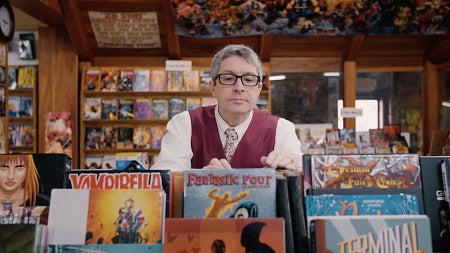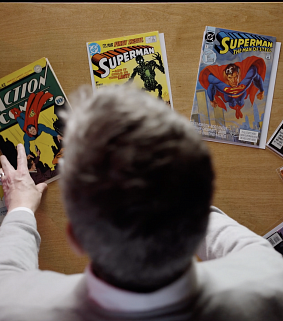Marvel and Penguin Classics are producing a new series, starting with the Black Panther, Captain America, and The Amazing Spider Man.

Ben Saunders, UO Professor of Comic Studies, is working with Marvel Comics on a new collaboration series with Penguin Classics.
The first three books published in the series will be Black Panther, Captain America and The Amazing Spider-Man, with Saunders serving as the series editor and author of the scholarly introductions for the latter two. This series marks the first time that Penguin Classics has ever published a comic.
“Penguin Classics is one of the oldest and most distinguished publishers. They have never published comics before of any kind,” Saunders said. “So, this is a canonization of comics as a medium that is worthy of study. It’s a huge step.”
Saunders founded the world’s first undergraduate minor in comic studies here at the University of Oregon in 2012. The minor explores historical, international and critical perspectives on comics and cartoon studies. Saunders has also served as curator for multiple museum exhibitions of comic book art, with his most recent exhibition being Marvel Universe of Super Heroes Exhibit on display across the U.S. and Canada in 2019.
Black Panther, Captain America and The Amazing Spider man have been leading titles for Marvel for decades. They’ve gone on to spawn movies that have grossed millions of dollars and captivated millions of fans.
“I feel so incredibly lucky to be working on this series,” Saunders said. “I’ve loved this material all my life. I became a professor because I learned to read from comics. There’s a direct connection between my childhood, the gateway to literacy which a lot of these texts were to me, and where I am now. It’s very exciting to be able to say I was a part of this process.”
Although stories from Marvel dominate global cinema, comics weren’t always viewed as an acceptable form of literature. Saunders said they were seen as harmful to children during the 1950s. Children who read comic books, the notion went, were thought to become overly dependent on images and were unable to read traditional, longer form books. Sanders said people also worried that children were more likely to become criminals or commit horrific acts if they read crime and horror comics.
This led to the burning of comics across the U.S. between 1948 and 1954 and U.S. Senate hearings on the possible relationship between comics and juvenile delinquency. “Every librarian and educator for the last 30 years has known that this notion was nonsense,” Saunders said. “But it was an idea taken very seriously in the ‘50s.”

“Some of these comics were offering pretty radical political content for 10 cents in a format that was available to children,” Saunders said. “A story called “The Guilty” published by EC comics in 1952 depicted the murder of an African-American man by a police officer. The man is shot in the back; the officer claims he was trying to escape and gets away with the crime. The comic concludes with an editorial statement about how the crime we have witnessed is also an abuse of the constitution, and urges the reader to stand up for the rights of every American.”
There weren’t many forms of popular media in the U.S. that were producing messages like these in a low-cost format, allowing a child or teenager to buy and learn from. Saunders said this accessibility was one of the reasons people were upset by the material.
“There are people around today who remember the 1950s and remember that moment in time for comics,” Saunders said. “So, the idea that comics could go from being seen as intellectually harmful and ethically reprehensible to something that is seen as a publication under the line of Penguin Classics is mind blowing.”
Saunders’ scholarly introductions for Captain America and The Amazing Spider-Man will focus on the real-world origin and historical creation of these characters. Saunders will explore the careers of Jack Kirby, Joe Simon, and Steve Ditko, the initial creators of the characters, asking what their initial vision for the heroes was, and how that’s shifted through time into the characters of today.
The art style of the comics made them initially groundbreaking. No other comic books looked like those drawn by Jack Kirby and Steve Ditko, Saunders said. At the same time, the superhero genre also underwent a transition at their hands, morphing into a genre associated with the relative moral simplicity of wartime propaganda that became more inclined to explore the relationship between power and responsibility.
The method in which these comics were created set them apart, as well. Typically, mainstream comics are produced with a “full script” method, in which a writer describes the contents of each panel and writes the dialogue before handing the script to the artist.
However, at Marvel in the 1960s, Saunders said the method was flipped. Artists such as Kirby and Ditko might receive a short synopsis or even just a brief conversation with editor Stan Lee, before penciling all 20 pages of that month’s story.

The artists were the ones who controlled the plot and pacing of the story, and would frequently introduce new characters. Then, Stan Lee would add in the dialogue after the art was finished, Saunders said. This became known as the “Marvel Method,”
Under Stan Lee, Marvel’s characters were also all placed in a shared universe — their stories interwoven, producing a vast, interconnected narrative in the history of storytelling, Saunders said. “It’s a fantasy about the relationship between power and responsibility,” Saunders said. “With great power comes great responsibility, and that’s the challenge that the genre asks us to think about.”
While comics have had a long, storied history since their inception in the 1940s, their lasting effects on popular culture have reached a culmination with the immense popularity of today’s Marvel and DC cinematic universes. To Saunders, it’s the poignant stories of the flawed human beings at the core of each character combined with their uncomplicated moral imperatives that give the superhero story a timeless appeal.
“The Penguin Classics will be of real value to someone who wants to quickly get up to speed on the decades of history and storytelling of these characters,” Saunders said. “They will, in a way, try and capture the essence of what was important about the characters in the earliest iterations and the first 10 years of the company. It’s not just about introducing readers, it’s about what would actually be helpful in a classroom, or helpful for a future creator.”
By Victoria Sanchez and Cole Sinanian, College of Arts and Sciences Communications
